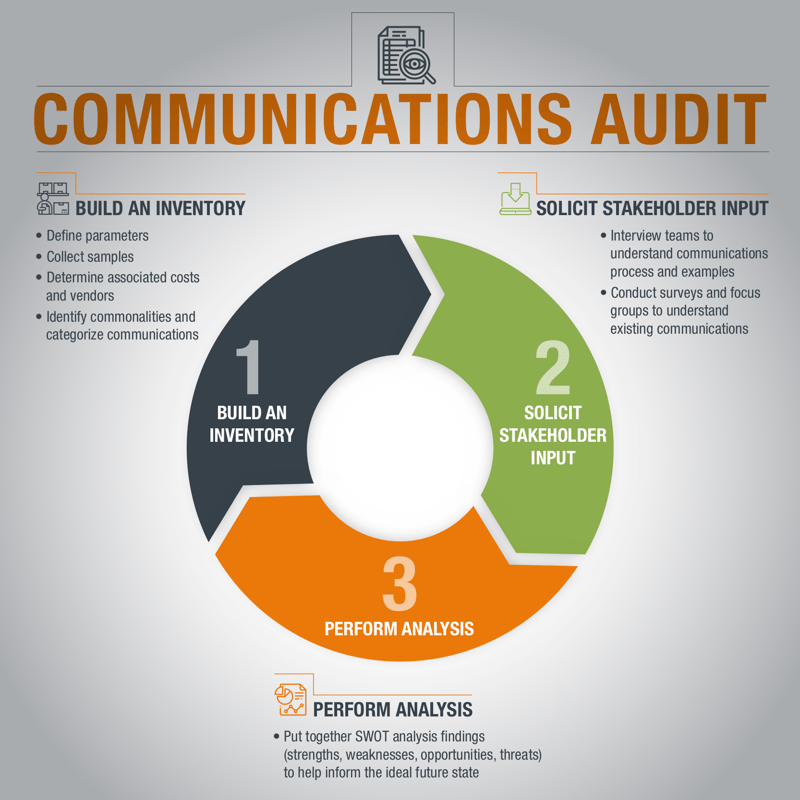Determine the Scope of Your Audit
Think about the types of communications that will be under the purview of your audit. Will you examine:
- Internal and/or external communications?
- For internal communications, will you look at company-wide communications, or those limited to a particular audience or department? Will you look only at communications sent from a certain department or sender, or all mass communications?
- For external communications, will you look at all communications, or only those that go to a particular customer profile, investors, press, or other stakeholders?
- Multiple mediums of communication, or only those sent by certain vehicles, i.e. email, blog posts, mailers, press releases, or handouts?
Collect Samples
This may be the most time consuming portion of the audit. Reach out to the target audience of your communications, for instance colleagues in a particular department. Ask them to send or load to a repository all communications that meet your audit criteria, which they’ve received during a certain time period.
Now, organize the information. Consider building an inventory spreadsheet, adding a line item for each communication showing the send date, category (informational vs. call to action), sender, recipients, urgent vs. non-urgent, etc.
You may also find it helpful to include when each item was last reviewed and by whom, and where the most up-to-date versions are housed. This will help to streamline future updates and ensure that content is always approved, timely, and relevant.
Perform an Analysis
Start to draw conclusions from the bigger picture you’ve created. For instance, take a look at:
- How many emails are recipients getting from each sender in a given month?
- Are there opportunities to combine communications?
- Are the communications generating the intended types and levels of engagement?
- Is there consistency with respect to branding, voice and type of content?
- Which stakeholders need to be involved when making future recommendations?
As part of this, solicit input from recipients. You can do this via surveys, focus groups, or even one-to-one discussions. Do the recipients view the communications favorably? Do they find the material useful? Would they prefer to be communicated with more or less often or via different vehicles?
It’s important to view the overall experience from the eyes of the end user. What needs do they have, and how are you interacting with them? Communications have a tendency to be created out of need, without looking at the holistic user experience – which is why an audit can be so beneficial to building out a strategic plan.
From here, you can put together SWOT analysis findings (strengths, weaknesses, opportunities, and threats) related to the current communications plan, which can inform your future state.

Communications Strategy: Make Recommendations for the Future State
Given your learnings from the audit, put together an ideal picture of your communications plan. This can include:
- Updating branding or using the opportunity to roll out new branding
- Retiring extraneous communications that suck time and effort without producing the intended results
- Delivering certain information via different communication vehicles
- Combining communications that have historically been sent separately
- Revamping existing communications to make it clear to the reader WHY they need to know this information and WHAT they need to do with it
- Creating an internal process for oversight on communications sent from various teams or departments
Put the Plan Into Play
Present your recommendations to decision makers for final approval. Once they are on board, start rolling it out. Think realistically about the timeframe of the changes, and which changes to tackle first, second, and so on. It’s often wise to start with some quick wins to gain momentum and traction, then making changes that will be most beneficial and impactful.
Keep Improving
Once the revamped plan is in place, continue to review the materials in your inventory from a branding, compliance and user-experience perspective on a regular basis, making any necessary updates. Monitor the plan’s effectiveness by conducting a similar communications audit every year or two. With a baseline in place, measuring success and areas of potential improvement will likely be less of an undertaking.
Conducting a communications audit is an important step in ensuring that your communications are effective tools that serve your company and its stakeholders. To discuss your communications strategy in more detail, send us a note.

